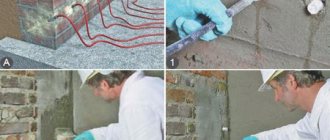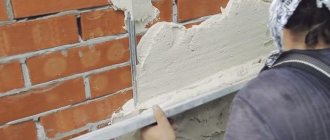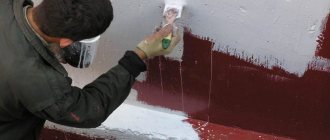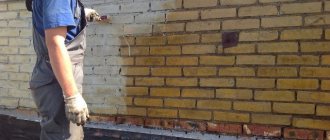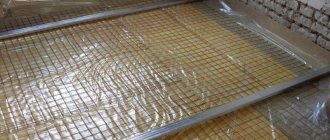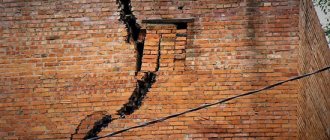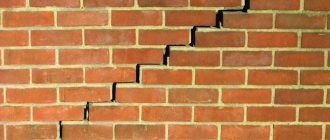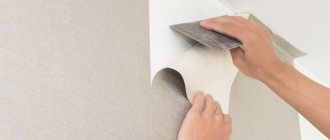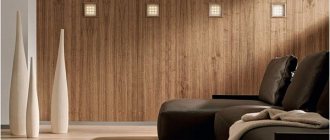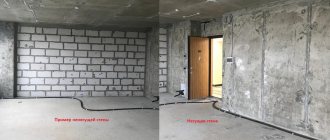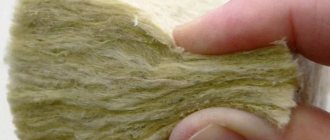Water is man's friend. We are practically made up of it, and it is vital. However, when it comes to building materials, water or excess moisture can have a negative impact on them. To avoid this, you will need to waterproof the outside of the brick wall. You can complete the task yourself or hire workers. The process is carried out both during construction and already on the finished brick wall.
Why protect brick walls from moisture?
Waterproofing walls and foundations is an integral part of construction work, which is carried out during the construction of buildings. Thanks to this, the walls will be less susceptible to negative factors such as precipitation and strong temperature fluctuations. After all, if the structure is unprotected from moisture, it will gradually deteriorate, cracks and deformations will begin to appear. This is especially true for buildings located in humid regions.
The word waterproofing itself consists of two parts: “hydro,” which translates as water, and “insulation.” That is, waterproofing is a process that allows you to protect or isolate a particular material from the negative effects of moisture. There are several rooms in the house that constantly have high humidity. We are talking about the kitchen, bathroom, garage, basement, bathhouse or sauna. If necessary, it is possible to carry out waterproofing work separately for a specific room. Or start building it from the outside. In this case, waterproofing the external walls allows you to protect the house completely.
So, without a waterproofing layer, the walls will be vulnerable to the negative influence of moisture; not only will the structure begin to deteriorate, but water will constantly penetrate inside. For example, during heavy rain, there is a possibility of flooding in the basement or garage. The waterproofing layer of a brick wall serves as a barrier that does not allow moisture to pass through. There will be no “crying walls” effect inside, and the humidity level inside will be optimal. As a result, the surface of the walls will not become covered with fungus or mold.
It is advisable that waterproofing of the external walls of the house is carried out at the stage of their construction. Protecting the walls of an already built house will be more expensive and more difficult to implement. There are many materials on the construction market for these purposes: mastics, penetrating waterproofing for bricks, rolled materials, injection pastes. They are different and have their own characteristics. Thanks to them, you can protect the structure both outside and inside.
How to prevent dampness in a brick cellar
In most cases, the presence of moisture and dampness in the basement is a drawback that needs to be eliminated. The methods listed above are used for internal waterproofing of the finished structure. Waterproofing a brick cellar from the inside from groundwater, especially if it is constantly present, cannot guarantee a stable result, so better results can be achieved by performing insulating work during the construction process, since the waterproofing layer on the outside in this case will prevent moisture from entering the thickness of the walls, floor and ceiling design. Due to the fact that the outer layer of protection does not allow moisture to reach the surface, additional internal treatment may be unnecessary.
The only thing that needs to be done then is to ensure air circulation inside the room to avoid moisture condensation. Equipping basements with ventilation is a mandatory measure.
Moisture and brickwork
The most effective method of waterproofing brickwork is used during the construction of a house. There are different options on how this can be done. The most vulnerable part of the structure is the base, since it most often comes into contact with water, and its continuation (the foundation) is located in the soil layer. To protect it, concrete mixtures or asphalt plaster are used. These materials have pronounced properties to repel water, preventing it from penetrating inside. An equally popular option is waterproofing materials in liquid or roll form.
Waterproofing for bricks should be done from the outside, since there is no point in doing it from the inside. The inner layer will protect the walls from moisture in the room itself, but the main source is from outside the building. Moreover, the bricks may come into contact with the ground. If you protect them only from the inside, then water will penetrate into the structure of the material through the pores. And then it will begin to spread even to the upper floors along the brick walls. Dampness cannot be avoided. Brickwork is made from cement mortar or special glue. Constant exposure to fluid will negatively impact integrity.
Therefore, if the base is made of brick, it is necessary to waterproof the masonry.
Mold
By this general name we mean plaque that forms in a humid environment. In fact, the word "mold" is more of a colloquial word. In scientific language it is called mushrooms. Many types of mold under a microscope are very similar to the thickets of mushrooms as we are used to seeing them. Fungi feed on wood cellulose and other organic matter, but can even attack substrates such as plastic and concrete. Fungal spores are present almost everywhere, even in outer space, and germinate immediately as soon as they enter a favorable environment characterized by high humidity, heat and lack of air movement. That is why good ventilation deprives mold of at least two mandatory conditions for its appearance.
Many types of mold, namely the increased concentration of their spores in the air, pose a great danger to humans. Allergy sufferers and people with weakened immune systems are very sensitive to the presence of mold. In medical practice, there are many examples of deaths caused by black mold and other dangerous types of fungi.
Mold killing products are universal and equally effective for all types of mold fungi. In professional language they are called fungicides (from the English fungus - mushroom). According to their intended purpose, they are divided into preparations for wood and for concrete (brick). When using antifungal agents, it is necessary to strictly follow the manufacturer's instructions regarding the number of treatments and breaks between them.
Protecting the surface from moisture penetration
Before waterproofing a brick wall, it is important to prepare the surface. This includes:
- Removing old finishing material, if any;
- Removing protruding elements from the wall;
- Cleaning the wall from dirt, grease stains, rust and dust.
The next step is to apply a layer of primer material. The primer for waterproofing fills all the micropores in the structure of the material, preventing moisture from getting inside. After this, the wall is leveled and protective material can be applied to it. For example, liquid rubber applied in several layers. It is quite elastic and reliably protects the surface from moisture, and also has excellent tensile strength. Even if the foundation or masonry cracks, the rubber layer will withstand such deformation.
When working, it is important to use a deep penetration primer. Only this will allow you to achieve the desired result.
As an option, use roll-type materials on the walls. They are no less effective and durable. However, working with liquid products is somewhat easier. The simplest and most commonly used material for this purpose is roofing felt. It is loved for its low cost and availability, as well as for its high level of waterproofing of external walls. Most often, roll materials are used for plinths and foundations. When heated, the layer can take the desired shape.
If we talk about shortcomings, then they exist. It is difficult to work with roofing felt on your own; special attention is also paid to the joints, which are the weak point of the protective layer. And with mechanical impact, roofing felt can be damaged.
Important ! Ruberoid is a simple but outdated material. It has been replaced by more modern products with better characteristics. For example, Rubemast, Euroruberoid, Izospan, Stekloizol, Gidroizol.
Types of mold
There are several types of microorganisms and fungi that most often settle on wood. They differ in external characteristics, reproduction rate, toxicity of released products, and degree of deterioration of the material.
The most dangerous and aggressive type of mold is black mold, all strains of which multiply quickly, severely destroy wood, and can cause illness in humans. It is the most difficult to remove.
White types of mold can appear not only on wooden products, but also on food and various products. These fungi are removed faster and easier; they are less dangerous, although they can also cause irritation and allergies.
There are bluish types of mold that actively destroy wooden materials. They are especially dangerous for load-bearing structures, where they cause through-rotting. To remove them, the wooden surface must be cleaned mechanically and bleaches must be used.
Actinomycetes, bacteria similar in structure and properties to fungi, significantly worsen the performance characteristics of wood. When infected by these microorganisms, which appear primarily in places of high humidity, the softening of the material occurs very quickly. Infestation should be removed with strong antiseptics.
Protection from moisture of the base or foundation with waterproofing materials
The foundation is the foundation of the house. If you leave it without a protective layer, brick walls will not help here; the house may become deformed and even collapse. In addition, there is a direct connection between the base and the brick walls. For example, in winter the base can be completely covered with snow, in spring it is exposed to melt water, and in autumn and summer it is filled with water. All moisture can be transferred to the brick wall. To prevent this from happening, the foundation is also protected from moisture.
The main task in this case is to cut off the penetration of moisture into the brick wall. This physical process is called capillary suction of water from the soil. The simplest protection option is carried out at the stage of erecting a brick wall. Several layers of roofing felt or other rolled waterproofing are laid on the foundation.
Advice! You should not skimp on materials for waterproofing; they must be of high quality and purchased in sufficient quantities. This is the only way to protect the foundation and walls as effectively as possible.
Folk remedies
Homemade mold removal products can help get rid of small growths. In case of large lesions, their effectiveness will be low. The procedure usually needs to be repeated after 8-10 days.
Homemade mold removal products can help get rid of small growths.
Using bleach
The presence of chlorine in bleaches helps remove mold. The product is used to treat the white surface, otherwise stains will appear on the base, which will spoil the appearance. Do not use for wooden materials and plasterboard sheets. Bleach has a strong smell, you should wear a respirator and protective gloves when working.
The product is used to treat the white surface, otherwise stains will appear on the base, which will spoil the appearance.
Borax against mold
First, the surface is vacuumed to prevent the spores from spreading through the air. A glass of borax is mixed with 2.5 liters of water. The tool for applying the solution is a brush with stiff bristles. The layer must dry completely and do not wash it off.
A glass of borax is mixed with 2.5 liters of water.
Baking soda
Soda is mixed with water, the ratio can be made as follows: take a tablespoon of soda per glass of water. The solution is applied through a sprayer to the walls. When the layer is dry, the surface is washed and wiped dry.
Soda is mixed with water, the ratio can be made as follows: take a tablespoon of soda per glass of water.
Table vinegar
The bite is sprayed over the surface where there are lesions. Next, using a rag, distribute the layer deeper. After two hours it will be possible to clear the wall of the bite.
The bite is sprayed over the surface where there are lesions.
Ammonia
Alcohol is mixed in equal proportions with water and sprayed over the affected area. Wait a while and wash the layer. You need to protect yourself by wearing a respirator and gloves.
Alcohol is mixed in equal proportions with water and sprayed over the affected area.
Hydrogen peroxide
The substance can be used without dilution; the product does not cause harm to humans. But if peroxide is applied to wallpaper, it may turn white.
The substance can be used without dilution; the product does not cause harm to humans.
Lemon acid
You can also make an effective fungal remedy from citric acid. The proportions are based on mixing a teaspoon of acid with a glass of water. Convenient to use tile mortar.
The proportions are based on mixing a teaspoon of acid with a glass of water.
Tea tree oil
A harmless option for combating fungus for humans. For a glass of water you will need a teaspoon of oil. After applying the solution, you won’t have to wash it off, and you will still have protection from new formations.
A harmless option for combating fungus for humans.
Stationery glue
Mixing glue with water in equal proportions also serves as an antiseptic. But effectiveness does not appear for all types of formations, and will not help for large lesions.
Mixing glue with water in equal proportions also serves as an antiseptic.
Using penetrating waterproofing for masonry
As noted, brick has a porous structure and, as a result, quickly absorbs moisture. In winter, moisture in the brick can freeze and damage its integrity. To eliminate this process and protect the wall, penetrating waterproofing is used for brickwork. This is a modern material that has its advantages and disadvantages.
The name itself indicates exactly how the product works. The material is in a liquid state. Most importantly, it must be applied to a finished brick wall. The product penetrates into the structure of the brick, closing all the pores. It also has moisture-repellent properties. The created barrier prevents water or moisture from affecting the brick wall.
The most common penetrating materials for protecting a brick wall
If deep penetration waterproofing is used, the surface will become insensitive not only to water, but also to the influence of solvents, petroleum products and alkali. The construction market is full of products that protect brick walls. Here is a list of the most common ones:
- "Khureh." Made in Canada. Waterproofing is based on cement. It has active additives. Thanks to them, water will not penetrate into the structure of the material. In addition, they perform a protective function, since the wall becomes invulnerable to the effects of chlorides and corrosion. The principle of operation is simple: active additives pass into the pores, after which an insoluble compound is created. When the substance comes into contact with water, a crystalline structure is formed. Such compounds in the concrete mixture make it absolutely protected from external influences and moisture.
- Isomat Aquamat. Representative of coating-type waterproofing products that penetrate the structure. Most often used as a protective layer against water in swimming pools, wells and other similar structures. Product advantages: the composition is constantly in active condition after use, surfaces receive maximum moisture protection, structural elements are less vulnerable to mechanical damage, and the fittings are not afraid of corrosion. The product can be used in structures and containers used to supply drinking water.
- "Penetron". The product is made on the basis of quartz sand and cement (a special brand is used). Additionally, the raw materials are mixed with active substances. The product is intended for waterproofing work on reinforced concrete and other materials that have cracks no more than 0.4 mm wide. Penetron is also used to process brickwork, plaster and concrete structures made from a sand-cement mixture. The substance is applied both from the outside of the walls of the house and from the inside. It is environmentally friendly, it can be applied with a brush even on a damp surface; after crystallization, moisture will not penetrate up to 1 m deep.
- "Virtyoz". Penetrating type waterproofing for treating walls inside and outside. The packaging contains cooking instructions. This is a kind of waterproofing plaster, which, after mixing, is applied with a spatula or brush to the brickwork or concrete surface. After application, it is recommended to moisturize the surface for 3 days.
- "Waterplug." This is a dry mixture consisting of aluminate cement, quartz sand and active additives. With its help, it is easy to eliminate pressure leaks that form in concrete or brick structures. Feature: quick setting, ability to expand. The material is used together with Penetron. The product is environmentally friendly and therefore suitable for structures that provide water supply.
To summarize, we can say that waterproofing bricks with deep penetration means has a lot of advantages. They are affordable, easy to use, environmentally friendly and, most importantly, can be used on an already erected structure. The brick surface and masonry will be reliably protected, and the penetrating properties allow the products to be used even on double silicate bricks.
Important! It should be borne in mind that such waterproofing is universal and will help achieve complete protection. If it copes with the walls, then it is better to additionally protect the foundation with horizontal insulation. For maximum effect.
What are stone water repellents used for?
Artificial and natural stones are often used for external cladding of facades, fences, when organizing paths, as well as for interior textured decoration of premises. The material may have a different structure - polished or embossed, but each of them has the ability to absorb moisture. Active moisture absorption negatively affects the appearance, leading to the formation of mold and overgrowth with moss or lichen, especially if the outer surface is embossed. When the temperature drops, moisture that penetrates the stone leads to cracking. To combat these negative factors, protection is used by applying hydrophobic agents.
A water repellent for artificial or natural stone is selected depending on the type of surface and the desired effect. There are universal products that are suitable for all types of surfaces. They are beneficial when it is necessary to process a façade made of combined materials, including a stone covering. No less effective are specialized liquids used exclusively for application to stone. They can be intended exclusively for interior work and be safe for food products
This is important for processing sinks and countertops in the kitchen.
On a note! When choosing a hydrophobic product for external treatment, pay attention to whether it has UV protection, thanks to which the material will last longer.
Water repellents for stone can be intended only for protection or include additional options such as creating a “wet stone” effect. After processing, the top layer acquires a slight glossy coating, which makes the stone surface brighter. Packages with water-repellent liquid always indicate similar properties. For this purpose, for example, the water repellent Optimist is suitable. It has positive reviews, especially regarding the processing of external stone cladding.
For artificial and natural stone, water repellents must be selected depending on the type of surface.
Before large-scale application of a water repellent to a stone surface, test its effect on the remains of the cladding or in an inconspicuous place. This way you can evaluate the degree of drying, processing speed, the need for a second coat and the quality of the “wet” effect (if you have chosen such a product).
Stages of work execution
The whole process can be divided into several stages. First you need to decide on protection. Choosing a waterproofing material is a responsible task; you should not buy cheap materials.
Then the algorithm is as follows:
- Surface preparation.
- Preparation of products, if required. The dry penetrating mixture is mixed according to the instructions, the liquid mixtures are simply stirred.
- Then they begin to apply the protective composition.
More precise instructions can be found on the manufacturer's packaging, as they may differ for each mixture. After using protective products for surfaces, you don’t have to worry about the durability of building materials. The room will have a comfortable microclimate and nothing from outside will disturb it. And so that the work is not done in vain, it is better not to skimp on impregnations.
